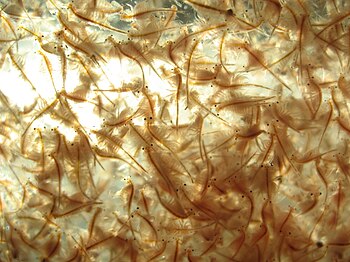 |
| Aquarium - Dried foods for fishes (Photo credit: Wikipedia) |
There are different types of discus fish foods, which mainly contains three categories:
Dry food, frozen food and live discus food. These can be further classified as sinking food, slow sinking food and floating fish food. Since discus, fish are mostly mid-water feeders slow sinking fish food for discus is most preferred.
Different types of sinking fish food for discus are:
Flakes: Flakes come under the category of top floating food but if you pinch them a big before feeding they sink down.
Pellets: Small and mostly round shaped, pellets are both sinking and floating. Giving dry pellets to fish can cause them to bloat, therefore, soak them in water for a little while before feeding.
Granules: These are smaller forms of pellets are can be fed in the same way you feed the pellets.
Wafers and tablets: These are one of the most popular forms of sinking fish food for discus. They have a very well balanced ingredient content. Although they sink rapidly but since they are small enough to be eaten in one bite the fish eat them up quickly. Also, they don't cloud the water.
Gels: These are preprocessed slow sinking food for fish. These then being thawed, then mixed with homemade food or other frozen food and then frozen again to feed the fish. They can be used to give your fish a varied diet.
Slow sinking discus fish food is preferred because then the fish can reach it easily. If the fish sinks too fast then they will not be able to reach it and it will rot in the bottom and can harm the fish. Discus fish follow a routine and therefore you have to keep in mind to feed them at fixed times every day.
Also, since discus fish like to follow a routine, therefore, feed them at regular intervals and give small feedings at a time. They like to eat frequently and hence if you give them to feed only once or twice a day, it will go waste and the fish will starve. Any variation from the routine will make them confused and disrupt their system.
|


